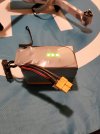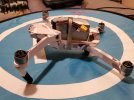cgmaxed
Well-Known Member
One of the entries on this post said the Mavics have an internal smaller battery that gets charged by the large smart battery. It's the small internal battery that distributes the power to the electronics, the post says. SO, I guess the heat your talking about will come from the extra weight? Incidentally, I routinely fly at night with 2x 2000 lumen spot lights facing the ground (they are high powered led torch lights, not made for a drone. They each have a single somewhat heavy 5000-mah battery). Looks like a police chopper without the noise. Anyway, I did notice, the battery, and motors are a little hotter when I land, but I have never had issues except a loss of about 5-6 minutes of flight time. You can hear the stress on the props, due to the increased rotor speed needed to lift the weight, but the flight dynamics remain stable. I still get decent flight times and stability, minus the 5-6 minutes. It's nice to see the ground when flying at night. It does tend to piss some of my neighbors off when I pass over their homes. C'est la vie.That's fair enough, but you will be putting extra load on the motors and esc's with the extra heat.
How have you connected up the extra batteries?
I can't see how they can charge the mavic pack, surely if connected up in parallel with mavic pack you are juust creating one big 3s battery?
Without my spot lights and a 5-7 minute mod boost on flight time, there is some potential. I Usually fly from a 2nd floor balcony and or a roof purch 3 stories high on my roof line for VLOS above trees and stuff. SO, I usually fly kind of far away to get descent shots. I'm lucky to live in florida, just 6 miles from the coast. Their is a bird preserve and many wooded areas with gators around my home. Lot's to look at, a little extra flight time could help me out quite a bit. By the way, It looks like the extra flight batteries take away 5-7 minutes of flight, but give an extra 15 minutes total. This turns out to be an extra 7 minutes of flight, i guess. You are right, I don't know what the long term effects would be on the drone, putting it under the stress of such a load, at longer flight intervals. The batteries might get hot and swell.=, especially on hot days. I would never fly the drone with those extra flight batteries if the outdoor operating temps got near the 40c operating temp limits of the drone. High outdoor temps and flying with extra weight is a bad idea. I wonder when they will be releasing the new tiny (uav sized) Hydrogen fuel cell Polymer batteries. I hear they can hold a lot more power at a much lighter weight. This will be a game changer for drones.. Electric cars are using hydrogen batteries or a version of hydrogen fuel cell ( a larger version of course). Hydrogen based electrical power is very efficient. Quoted below, is a company called AMS COMPOSITE CYLINDERS. They make UAV sized hydrogen batteries. They are likely too expensive for release to the general consumer public. THEY CAN FLY FOR HOURS ! NOT JUST MINUTES!.
"At AMS Composite Cylinders, we have already been heavily involved in several Unmanned Aerial Vehicle (UAV) projects. Using hydrogen fuel cells and our ultra-lightweight cylinders, the drone manufacturers have been able to deliver UAVs with flight times of several hours."













